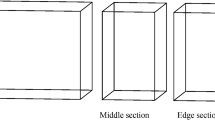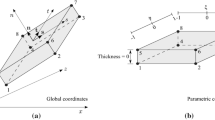Abstract
Steel fiber reinforced concrete (SFRC) is an appropriate material for protective structure and may undergo fire, impact and the coupled effects of them. To investigate the dynamic failure behavior of SFRC after elevated temperature, a mesoscale simulation method was established. In the approach, the SFRC was regarded as a four-phase composite material consisting of aggregate particles, mortar matrix and the interfacial transition zones between them as well as fibers. Each phase has its own independent thermal and mechanical properties. During the simulations, a sequentially coupled thermal-stress procedure was employed. In detail, thermal conduction within SFRC specimens was conducted firstly. Then, taking the results of damage and temperature field as the initial state, the dynamic failure behavior of SFRC under uniaxial compression was modelled. Comparison between simulation results and experimental observations reveals the rationality and accuracy of the simulation method. Based on the calibrated simulation approach, the mechanical performances of SFRC under various temperature and strain rates were simulated. Both the temperature degradation and strain rate enhancement effects on the apparent property of SFRC were studied. The results indicate that steel fiber can effectively improve the dynamic mechanical properties of concrete after high temperature and more adequately prevent crack evolution under high strain rate. The fiber enhancement effect on strength is weakened with the increase of strain rate, while that is more significant with the increase of temperature.












Similar content being viewed by others
References
Hao H, Hao Y, Li J, Chen W (2016) Review of the current practices in blast-resistant analysis and design of concrete structures. Adv Struct Eng 19(8):1193–1223
Huo JS, He YM, Xiao LP, Chen BS (2013) Experimental study on dynamic behaviours of concrete after exposure to high temperatures up to 700°C. Mater Struct 46(1/2): 255–265
Chen L, Fang Q, Jiang X, Ruan Z, Hong J (2015) Combined effects of high temperature and high strain rate on normal weight concrete. Int J Impact Eng 86:40–56
Park S, Yim HJ (2016) Evaluation of residual mechanical properties of concrete after exposure to high temperatures using impact resonance method. Constr Build Mater 129:89–97
Ma Q, Guo R, Zhao Z, Lin Z, He K (2015) Mechanical properties of concrete at high temperature—a review. Constr Build Mater 93:371–383
Malvar LJ, Ross CA (1998) Review of strain rate effects for concrete in tension. ACI Mater J 95(6):735–739
Zende A, Kulkarni A, Hutagi A (2013) Behavior of reinforced concrete subjected to high temperatures—a review. J Struct Fire Eng 4(4):281–295
Bischoff PH, Perry SH (1991) Compressive behaviour of concrete at high strain rates. Mater Struct 24(6):425–450
Thomas RJ, Sorensen AD (2017) Review of strain rate effects for UHPC in tension. Constr Build Mater 153:846–856
European Committee for Standardization (2004) Eurocode 2: design of concrete structures—part 1–2: general rules-structural fire design, EN 1992-1-2:2004. The Committee, Brussels
Marcos-Meson V, Michel A, Solgaard A, Fischer G, Edvardsen C, Skovhus TL (2018) Corrosion resistance of steel fibre reinforced concrete—a literature review. Cem Concr Res 103:1–20
Lok TS, Zhao PJ (2004) Impact response of steel fiber-reinforced concrete using a split Hopkinson pressure bar. ASCE J Mater Civil Eng 16(1):54–59
Lau A, Anson M (2006) Effect of high temperatures on high performance steel fibre reinforced concrete. Cem Concr Res 36(9):1698–1707
Wang Z, Liu Y, Shen RF (2008) Stress–strain relationship of steel fiber-reinforced concrete under dynamic compression. Constr Build Mater 22(5):811–819
Wang ZL, Shi ZM, Wang JG (2011) On the strength and toughness properties of SFRC under static–dynamic compression. Compos Part B-Eng 42(5):1285–1290
Liang X, Wu C (2018) Meso-scale modelling of steel fibre reinforced concrete with high strength. Constr Build Mater 165:187–198
Düğenci O, Haktanir T, Altun F (2015) Experimental research for the effect of high temperature on the mechanical properties of steel fiber-reinforced concrete. Constr Build Mater 75:82–88
Sun X, Zhao K, Li Y, Huang R, Ye Z, Zhang Y, Ma J (2018) A study of strain-rate effect and fiber reinforcement effect on dynamic behavior of steel fiber-reinforced concrete. Constr Build Mater 158:657–669
Yoo D, Banthia N (2017) Mechanical and structural behaviors of ultra-high-performance fiber-reinforced concrete subjected to impact and blast. Constr Build Mater 149:416–431
Caverzan A, Cadoni E, di Prisco M (2013) Dynamic tensile behaviour of high performance fibre reinforced cementitious composites after high temperature exposure. Mech Mater 59:87–109
Xiao J, Li Z, Xie Q, Shen L (2016) Effect of strain rate on compressive behaviour of high-strength concrete after exposure to elevated temperatures. Fire Saf J 83:25–37
Zhai C, Chen L, Fang Q, Chen W, Jiang X (2017) Experimental study of strain rate effects on normal weight concrete after exposure to elevated temperature. Mater Struct 50(1):40
Yao W, Liu H, Xu Y, Xia K, Zhu J (2017) Thermal degradation of dynamic compressive strength for two mortars. Constr Build Mater 136:139–152
Jin L, Hao H, Zhang R, Du X (2018) Determination of the effect of elevated temperatures on dynamic compressive properties of heterogeneous concrete: a meso-scale numerical study. Constr Build Mater 188:685–694
Dassault Systèmes Simulia (2014) ABAQUS 6.14
Wriggers P, Moftah SO (2006) Mesoscale models for concrete: homogenisation and damage behaviour. Finite Elem Anal Des 42(7):623–636
Shadafza E, Saleh Jalali R (2016) The elastic modulus of steel fiber reinforced concrete (SFRC) with random distribution of aggregate and fiber. Civil Eng Infrastruct J 49:21–32
Pedersen RR, Simone A, Sluys LJ (2013) Mesoscopic modeling and simulation of the dynamic tensile behavior of concrete. Cem Concr Res 50:74–87
Du X, Jin L, Ma G (2014) A meso-scale numerical method for the simulation of chloride diffusivity in concrete. Finite Elem Anal Des 85:87–100
Jin L, Zhang R, Du X (2018) Characterisation of the temperature-dependent heat conduction in heterogeneous concretes. Mag Concr Res 70:325–339
Grondin F, Matallah M (2014) How to consider the interfacial transition zones in the finite element modelling of concrete? Cem Concr Res 58:67–75
Šavija B, Pacheco J, Schlangen E (2013) Lattice modeling of chloride diffusion in sound and cracked concrete. Cem Concr Compos 42:30–40
Šavija B, Luković M, Pacheco J, Schlangen E (2013) Cracking of the concrete cover due to reinforcement corrosion: a two-dimensional lattice model study. Constr Build Mater 44:626–638
Du X, Jin L (2014) Meso-scale numerical investigation on cracking of cover concrete induced by corrosion of reinforcing steel. Eng Fail Anal 39:21–33
Xu Z, Hao H, Li HN (2012) Mesoscale modelling of fibre reinforced concrete material under compressive impact loading. Constr Build Mater 26(1):274–288
Fang Q, Zhang J (2013) Three-dimensional modelling of steel fiber reinforced concrete material under intense dynamic loading. Constr Build Mater 44:118–132
Xu Z, Hao H, Li HN (2012) Mesoscale modelling of dynamic tensile behaviour of fibre reinforced concrete with spiral fibres. Cem Concr Res 42(11):1475–1493
Crank J, Nicolson P (1996) A practical method for numerical evaluation of solutions of partial differential equations of the heat-conduction type. Adv Comput Math 6(1):207–226
Zoth G and Hänel R (1988) Appendix. In: Haenel R, Rybach L, Stegena L (eds) Handbook of terrestrial heat-flow density determination. Kluwer Academic Publishers, Dordrecht, pp 449–468
Černý R, Maděra J, Poděbradská J, Toman J, Drchalová J, Klečka T, Jurek K, Rovnaníková P (2000) The effect of compressive stress on thermal and hygric properties of Portland cement mortar in wide temperature and moisture ranges. Cem Concr Res 30(8):1267–1276
Vosteen H, Schellschmidt R (2003) Influence of temperature on thermal conductivity, thermal capacity and thermal diffusivity for different types of rock. Phys Chem Earth (Parts A/B/C) 28(9/11):499–509
Grassl P, Pearce C (2010) Mesoscale approach to modeling concrete subjected to thermomechanical loading. ASCE J Eng Mech 136(3):322–328
CEB-FIP (2010) CEB-FIP model code 2010, fib bulletin 55. International Federation for Structural Concrete, Lausanne, Switzerland
China Association for Engineering Construction Standardization (2006) Technical code for fire safety of steel structure in buildings, CECS 200: 2006. China Planning Press, Beijing
Khan MI (2002) Factors affecting the thermal properties of concrete and applicability of its prediction models. Build Environ 37(6):607–614
Huan Y, Fang Q, Chen L, Zhang Y (2008) Evaluation of blast-resistant performance predicted by damaged plasticity model for concrete. Trans Tianjin Univ 14:414–421
Aref AJ, Dolatshahi KM (2013) A three-dimensional cyclic meso-scale numerical procedure for simulation of unreinforced masonry structures. Comput Struct 120:9–23
Du X, Jin L, Ma G (2014) Numerical simulation of dynamic tensile-failure of concrete at meso-scale. Int J Impact Eng 66:5–17
Lubliner J, Ollivier J, Oller S, Oñate E (1989) A plastic-damage model for concrete. Int J Solids Struct 25(3):299–326
Lee J, Fenves G (1998) Plastic-damage model for cyclic loading of concrete structures. ASCE J Eng Mech 124(8):892–900
Zhai C, Chen L, Xiang H, Fang Q (2016) Experimental and numerical investigation into RC beams subjected to blast after exposure to fire. Int J Impact Eng 97:29–45
Qiu Y, Lin Z (2006) Testing study on damage of granite samples after high temperature. Rock Soil Mech 27(6):1005–1010 (in Chinese)
Chen Y, Ni J, Shao W, Azzam R (2012) Experimental study on the influence of temperature on the mechanical properties of granite under uni-axial compression and fatigue loading. Int J Rock Mech Min 56:62–66
Comité Euro-International du Béton (1988) Concrete structures under impact and impulsive loading, CEB Bulletin No. 187. The Committee, Lausanne, Switzerland
ISO (1999) Fire resistance test on elements of building construction, ISO 834-1. International Standards Organization, Geneva
Gao C (2013) Experimental research on mechanical properties of concrete and reinforced concrete after high temperature. Yangzhou University, Yangzhou (in Chinese)
Bamonte P, Gambarova PG (2010) Thermal and mechanical properties at high temperature of a very high-strength durable concrete. ASCE J Mater Civil Eng 22(6):545–555
Ripani M, Etse G, Vrech S, Mroginski J (2014) Thermodynamic gradient-based poroplastic theory for concrete under high temperatures. Int J Plast 61:157–177
Ren W, Xu J, Su H (2016) Dynamic compressive behavior of basalt fiber reinforced concrete after exposure to elevated temperatures. Fire Mater 40(5):738–755
Jin F, Xu J, Fan F, Su H (2013) Strength property of steel fiber reinforced concrete at elevated temperature. B Chin Ceram Soc 32(4):683–686 (in Chinese)
Funding
Funding was provided by National Natural Science Foundation of China (Grant Nos. 51822801 and 51978022).
Author information
Authors and Affiliations
Corresponding authors
Additional information
Publisher's Note
Springer Nature remains neutral with regard to jurisdictional claims in published maps and institutional affiliations.
Rights and permissions
About this article
Cite this article
Jin, L., Hao, H., Zhang, R. et al. Mesoscale Simulation on the Effect of Elevated Temperature on Dynamic Compressive Behavior of Steel Fiber Reinforced Concrete. Fire Technol 56, 1801–1823 (2020). https://doi.org/10.1007/s10694-020-00955-5
Received:
Accepted:
Published:
Issue Date:
DOI: https://doi.org/10.1007/s10694-020-00955-5




